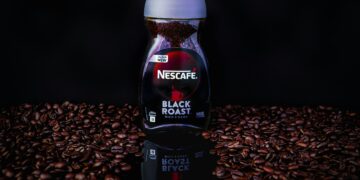Table of Contents
My journey into the world of homemade nitro cold brew began with a familiar blend of excitement and ambition.
I had fallen hard for the creamy, cascading magic served at my local coffee shop—that velvety texture, the naturally sweet finish, the mesmerizing visual of the bubbles settling into a dark, rich brew with a dense, Guinness-like head.1
Convinced I could replicate this experience at home, I invested a not-insignificant $300 into a shiny new mini-keg system.
I pictured myself pulling perfect, on-demand nitro pours for friends, becoming the undisputed coffee champion of my social circle.
I dove into online forums and blogs, meticulously following what seemed to be the standard advice.
I brewed a batch of cold brew using a popular recipe, charged the keg with a pure nitrogen cartridge, and waited with the patience of a saint.
The moment of truth arrived.
I pulled the tap handle, my heart pounding with anticipation.
What came out was not a beautiful cascade.
It was a sad, flat, disappointingly bitter stream of coffee that settled into a lifeless brown liquid in my glass.3
There was no foam, no creaminess, just the taste of failure and wasted money.
That $300 glass of sad coffee was my rock bottom.
It forced me to question everything I thought I knew and sent me on a quest to understand what was really happening inside that keg.
The answer, I would discover, had less to do with the typical barista playbook and everything to do with the fundamental principles of a professional kitchen.
In a Nutshell: The 5-Minute Path to a Perfect Pour (The Emulsion Mindset)
For those who want the destination before the journey, here is the cheat sheet I wish I had from the very beginning.
This is the core philosophy that finally unlocked consistent, café-quality nitro coffee in my own kitchen.
- Think Like a Chef, Not Just a Barista: Your goal is not merely to add bubbles to coffee. You are creating a stable culinary emulsion, a delicate mixture of liquid and gas. Every step of your process must serve this goal.
- The Base is Everything: Your cold brew is the foundation. It must be brewed from beans rich in the natural oils and proteins that act as stabilizers for the foam. A weak, thin, or poorly filtered base will always fail.
- Gas Matters: Use pure Nitrogen (N2) for that classic creamy, smooth texture. Nitrous Oxide (N2O), often used in whipped cream dispensers, creates a fluffier, sweeter foam but is a different experience entirely. Never use Carbon Dioxide (CO2), which creates large, fizzy bubbles and a sour, metallic taste.5
- The Holy Trinity of Infusion: A perfect nitro pour requires the precise application of three forces: Pressure (a steady 35-45 PSI), Cold (liquid temperature below 38°F or 3.3°C), and Agitation (vigorous shaking or forced infusion).8 Missing any one of these will result in failure.
- The Final Shear: For keg systems, a stout faucet equipped with a restrictor plate is non-negotiable. This component provides the final, crucial burst of energy that shears the nitrogen-infused coffee into a fine mist of micro-bubbles, creating the signature cascade and dense head.8
Part I: The Epiphany — Nitro Coffee Isn’t Coffee with Bubbles, It’s a Culinary Emulsion
My breakthrough didn’t come from a coffee blog.
It came while I was standing in my kitchen, frustratedly whisking oil and vinegar to make a salad dressing.
As I watched the two liquids that desperately wanted to separate come together into a creamy, stable vinaigrette, a lightbulb went off.
I wasn’t just mixing; I was emulsifying.
And in that moment, I realized my flat, lifeless nitro coffee wasn’t a brewing problem—it was a broken emulsion.
The Vinaigrette Analogy Explained
To understand nitro coffee, you must first understand a simple emulsion, like that vinaigrette.12
An emulsion is a stable mixture of two liquids that normally don’t mix, like oil and water.14
- Immiscible Liquids: You start with oil and vinegar (which is mostly water). Left alone, they will always separate into distinct layers due to their different densities and molecular structures.12
- Energy Input: To get them to mix, you must apply energy. Shaking a jar or whisking vigorously breaks one of the liquids (usually the oil) into millions of tiny droplets, dispersing them throughout the other liquid (the vinegar).12 This creates a temporary emulsion, but it will soon separate again.
- The Emulsifier: To make the mixture stable, you need an emulsifier. In a vinaigrette, this is often mustard or egg yolk.13 Emulsifiers are special molecules with a dual personality: one end is hydrophilic (it loves water) and the other is lipophilic (it loves oil).16 These molecules surround the tiny oil droplets, with their oil-loving ends pointing inward and their water-loving ends facing out. This creates a protective barrier that prevents the oil droplets from clumping back together, resulting in a stable, creamy mixture.14 The protein lecithin, found in egg yolks, is a classic and powerful natural emulsifier.13
Mapping the Analogy to Nitro Coffee
This culinary principle is the secret code to nitro coffee.
Once you see it, you can’t unsee it.
Every part of the process maps directly onto the science of emulsification.
- Cold Brew Concentrate is the water-based Continuous Phase of our emulsion. It is the liquid that will hold the dispersed bubbles.15
- Nitrogen Gas is the Dispersed Phase. It acts just like the oil in our vinaigrette, broken down into countless micro-droplets (or in this case, micro-bubbles).15
- High-Pressure Infusion & Agitation is the Whisking. This is the critical energy input required to break down the nitrogen and disperse it evenly throughout the coffee.12
- Coffee’s Natural Oils & Proteins are the unsung heroes. They function as the Emulsifiers and Surfactants, just like the lecithin in the egg yolk. These compounds, extracted during the cold brewing process, naturally migrate to the surface of the nitrogen micro-bubbles, creating a stable film that prevents the bubbles from collapsing and escaping.12
- A “Broken” Emulsion is a flat, separated, lifeless nitro coffee. The gas has escaped because the emulsion was never properly formed or stabilized.18
- A “Stable” Emulsion is a perfect nitro coffee: creamy, cascading, with a dense, long-lasting head. The micro-bubbles are held in a stable suspension by the coffee’s natural emulsifiers.23
This reframing changes everything.
A flat pour is no longer a mystery; it’s a broken emulsion, likely caused by insufficient energy (low pressure, not enough shaking), weak emulsifiers (a thin, under-extracted coffee base), or the wrong temperature.3
A bitter or metallic taste isn’t just a bad batch; it’s a contaminated continuous phase, where unwanted compounds are interfering with the delicate process of emulsification and ruining the final flavor.24
This model moves you from guessing at solutions to diagnosing problems from first principles.
Part II: Deconstructing the Perfect Nitro Emulsion: A Three-Pillar Framework
With the emulsion mindset as our guide, we can break down the creation of perfect nitro coffee into three distinct pillars.
Mastering each one is essential for building a stable and delicious final product.
Pillar 1: Mastering the Continuous Phase (Your Cold Brew Base)
This is the most overlooked yet most critical pillar.
Your cold brew isn’t just a beverage; it’s a chemical foundation.
You must craft a liquid that is not only flavorful but also structurally capable of forming a stable emulsion.
The Canvas: Selecting the Right Beans, Roast, and Origin
The choice of coffee bean directly impacts the emulsifying potential of your base.
Certain beans and roasts are naturally richer in the oils and proteins needed to stabilize the nitrogen foam.
- Roast Level: Medium-to-dark roasts are consistently recommended for nitro cold brew.2 The roasting process develops the coffee’s natural oils and caramelizes sugars. These oils are essential for creating the beautiful cascading visual and, more importantly, they act as a natural surfactant, helping to stabilize the foam.21 Darker roasts also tend to have lower acidity and bring out the rich chocolate and caramel notes that are a perfect complement to the creamy texture created by nitrogen.2
- Origin: Beans from Brazil and Colombia are frequently cited as ideal choices due to their full body, low acidity, and balanced, nutty, or chocolatey flavor profiles.21 These characteristics create a robust base that holds up well to the infusion process.
- Freshness: This is non-negotiable. Use beans that have been roasted within the last two to four weeks.2 As roasted coffee ages, its volatile aromatic compounds and precious oils degrade, leaving you with a flat, lifeless base that lacks the necessary components for a good emulsion.
The preference for darker roasts is not merely a matter of taste; it is a functional requirement.
The increased presence of surface oils and soluble proteins in a well-extracted dark roast provides the natural emulsifying power—akin to the lecithin in our vinaigrette analogy—that is essential for coating the nitrogen micro-bubbles and creating a dense, stable, long-lasting head.
A weak, thin coffee made from a very light roast may fail to produce a good cascade, not because of a flaw in the infusion technique, but because the continuous phase itself lacks the chemical backbone to support the emulsion.
Table 1: Coffee Bean Selection Guide for Nitro Cold Brew
| Origin | Recommended Roast Level | Flavor Profile | Nitro Suitability |
| Brazilian Santos | Medium-Dark to Dark | Low acidity, smooth, with prominent chocolate and nutty notes.21 | Excellent: High body and rich oils create a classic, stable, and creamy emulsion with dessert-like flavors. The quintessential nitro bean. |
| Colombian Supremo | Medium-Dark | Balanced acidity, caramel sweetness, and a full body.21 | Excellent: Produces a complex yet smooth nitro experience. The dense beans are ideal for cold brewing and nitrogen infusion. |
| Sumatran Mandheling | Dark | Earthy, full-bodied, with very low acidity and notes of dark chocolate and cedar.27 | Very Good: Creates an intensely rich and full-bodied nitro. The heavy body provides a fantastic foundation for a stable foam. |
| Ethiopian Yirgacheffe | Medium | Bright, floral, and citrusy with high acidity.27 | For the Adventurous: While less traditional, the vibrant fruit notes can create an intriguing contrast with the creamy texture. Best for experienced brewers who want to experiment. |
| Espresso Blends | Dark | Bold, robust, and designed for richness and crema (which is itself an emulsion).27 | Good: Can produce a very intense and thick nitro coffee. The dark roast ensures plenty of oils for foam stability. |
The Foundation: The Ideal Coarse Grind
The size of your coffee grounds is a critical variable in the 12- to 24-hour steeping process.
A coarse grind, similar in size to raw sugar or coarse sea salt, is universally recommended.2
If the grind is too fine, the vast surface area will lead to over-extraction during the long steep, pulling out bitter, astringent compounds and creating a harsh, muddy final product.2
If the grind is too coarse, the brew will be weak and under-extracted.
A consistent coarse grind from a quality burr grinder is far superior to the uneven chop of a blade grinder, ensuring even extraction and a clean flavor profile.29
The Recipe: Perfecting Your Ratio and Steeping
To gain maximum control over the final strength of your continuous phase, it is best to brew a concentrate first, which you can then dilute to your desired taste before infusion.
- Ratio: A common starting point for a cold brew concentrate is a coffee-to-water ratio between 1:4 and 1:8 by weight.2 A 1:5 ratio (e.g., 200 grams of coffee to 1000 grams, or 1 liter, of water) is a robust and reliable place to start.
- Steeping: Combine your coarse grounds and cold, filtered water in a large jar or pitcher, ensuring all the grounds are saturated. Cover and let it steep in the refrigerator for 12 to 24 hours.2 The cold temperature slows the extraction process, favoring the smooth, sweet flavor compounds over the more acidic and bitter ones that are readily extracted by hot water.33
- Dilution: After steeping, you will have a potent concentrate. This should be diluted before serving or infusing. A common dilution ratio is 1:1 with cold, filtered water, but you should adjust this to your personal taste.3 Remember, this concentrate is highly caffeinated; drinking it straight can easily lead to caffeine overdose, with unpleasant side effects like dizziness and nausea.36
The Polish: Flawless Filtration
The final step in preparing your continuous phase is filtration.
This is not just about clarity; it is a critical step to prevent equipment failure.
Stray coffee grounds are the primary enemy of a successful nitro infusion, as they can easily clog the tiny openings in a stout faucet’s restrictor plate or a keg’s carb stone, leading to a sputtering or completely blocked pour.8
Gently pour your steeped coffee through a fine-mesh strainer lined with cheesecloth or, even better, a dedicated nut milk bag.30
The key is to let gravity do the work.
Do not press or squeeze the grounds, as this will force bitter-tasting oils and fine sediment into your clean concentrate, compromising both flavor and texture.30
Pillar 2: Understanding the Dispersed Phase (The Gas)
The choice of gas is what defines the final texture of your drink.
The unique physical properties of nitrogen are precisely why it creates such a desirable mouthfeel, and understanding these properties is key.
The Science of the Micro-Bubble: Why Nitrogen, Not CO2
You cannot make nitro coffee with the CO2 canister from your soda machine.
While both are gases, their interaction with water is fundamentally different.
Carbon dioxide (CO2) is highly soluble in water, where it reacts to form carbonic acid.38
This chemical reaction is what gives carbonated beverages their characteristic sharp, tangy, or even sour taste and their large, aggressive bubbles.5
Using CO2 or a “beer gas” blend (which contains CO2) on coffee will result in a foul-tasting, acidic, and fizzy beverage within hours.4
Nitrogen (N2), on the other hand, is largely inert and has very low solubility in water—it is more than 50 times less soluble than CO2.38
This low solubility is the entire secret to the nitro effect.
Because nitrogen resists dissolving, it must be forced into the coffee under high pressure.9
When you open the tap, that pressure is suddenly released, and the nitrogen aggressively tries to escape the liquid.
The stout faucet’s restrictor plate, with its tiny holes, acts as a final gate, breaking this escaping gas into a turbulent cascade of microscopic bubbles.8
These tiny bubbles have an enormous collective surface area, which is what creates the thick, creamy texture and dense, stable foam.
The entire nitro system—high pressure, cold temperatures, and a stout faucet—is an engineering solution designed specifically to overcome and then leverage nitrogen’s low solubility to create a unique physical texture.
A Tale of Two Gases: Pure Nitrogen (N2) vs. Nitrous Oxide (N2O)
When making nitro at home, especially with a whipped cream dispenser, you will encounter two types of gas chargers: pure nitrogen (N2) and nitrous oxide (N2O).6
They are not interchangeable and produce distinctly different results.
- Pure Nitrogen (N2): This is the gas used in professional café setups. It creates the authentic nitro experience: a dense, creamy, long-lasting head with true micro-bubbles and a smooth, velvety body. Crucially, N2 is tasteless and odorless, so it does not alter the flavor of your carefully prepared cold brew, allowing its nuances to shine through.6
- Nitrous Oxide (N2O): This is the gas typically used for making whipped cream. It is more soluble in liquids than N2 and creates larger, fluffier, more frothy bubbles. N2O also has an inherently sweet taste, which it will impart to your coffee.6
The choice depends on your goal.
For an authentic, Guinness-like cascade and a pure coffee flavor, you must use pure N2.
For a quick, sweet, more dessert-like foamy coffee from a whipper, N2O is an accessible and common alternative.
Pillar 3: Mastering the Emulsification (The Infusion Process)
This is the “whisking” stage, where you apply the necessary energy to disperse the nitrogen into your cold brew base and form a stable emulsion.
Your equipment and technique are paramount here.
Choosing Your Weapon: Keg Systems vs. Whippers
There are two primary paths for the home nitro enthusiast, each with its own set of trade-offs.2
- Whipped Cream Dispensers: These are the most accessible and affordable entry point.43 A good quality stainless steel whipper costs under $100 and uses individual N2 or N2O cartridges. It’s perfect for making one or two servings at a time and is highly portable. The entire infusion process relies on a quick charge of gas followed by vigorous manual shaking.41
- Mini-Keg Systems: This is the path for the serious enthusiast. Systems from brands like GrowlerWerks or Royal Brew involve a higher initial investment but offer the ability to make and store larger batches (from 64 oz to over a gallon) under constant pressure for days or even weeks.42 They use a proper stout faucet and connect to either larger nitrogen tanks or cartridges, providing a more consistent, on-demand, café-quality experience.42
Table 2: Home Nitro System Showdown: Keg vs. Whipper
| Feature | Keg System (e.g., GrowlerWerks uKeg) | Whipped Cream Dispenser (e.g., iSi Gourmet Whip) |
| Initial Cost | $150 – $300+ | $50 – $120 |
| Cost Per Serving | Lower (especially with larger N2 tanks) | Higher (relies on single-use cartridges) |
| Batch Size | 64 oz to 2.5 gallons 42 | 1-2 cups (8-16 oz) 42 |
| Consistency/Control | High: Sustained pressure, stout faucet | Variable: Relies on manual shaking, no stout faucet |
| Ease of Use | More complex setup and cleaning | Very simple: Charge, shake, pour |
| Portability | Less portable, requires fridge space | Highly portable |
| Best For | The serious enthusiast making daily nitro coffee and valuing authenticity. | The occasional user wanting a quick, simple foamy coffee experience. |
The Holy Trinity of Infusion: Pressure, Temperature, and Agitation
Creating the nitro emulsion requires a sufficient total energy input.
This energy is delivered through a combination of these three critical factors.
- Pressure: High pressure is needed to overcome nitrogen’s low solubility and force it into the liquid. For keg systems, the standard serving pressure is between 35 and 45 PSI.8 This high pressure is also necessary to propel the coffee through the stout faucet’s restrictor plate with enough force to create the cascade. Some professional baristas even “super charge” a new keg at 60 PSI for a few minutes to kickstart the infusion before lowering it to serving pressure.10
- Temperature: Gas dissolves far more effectively into cold liquids than warm ones. This is a fundamental law of physics. Your coffee base must be thoroughly chilled, ideally to below 38°F (3.3°C), before you attempt to infuse it.3 Attempting to nitrogenate room-temperature coffee will result in a flat, disappointing pour.
- Agitation: Simply pressurizing a keg and letting it sit is a very slow path to infusion; it can take days for the gas to dissolve sufficiently.46 Agitation is the shortcut. By vigorously shaking or rolling the keg for several minutes, you dramatically increase the surface area contact between the gas and the liquid, forcing infusion to happen in minutes or hours instead of days.9 For whippers, this is the entire infusion method—a solid 30-45 seconds of vigorous shaking is mandatory.35
Think of it as an energy equation.
You need to supply a certain amount of total energy to the system.
You can achieve this with High Pressure + Long Time or, more efficiently, with High Pressure + Short Time + Intense Agitation.
A setup with low pressure, a short time, and no agitation is a guaranteed recipe for a failed emulsion.
Pro-Level Tools: The Role of Carb Stones and Cascade Lids
For keg users struggling with flat pours, the problem often lies in inefficient gas absorption.
A standard keg setup introduces nitrogen into the headspace above the coffee, meaning only the top surface of the liquid is in contact with the gas.
A carb stone (or carbonation stone) is a game-changer.
It is a small, porous metal cylinder that attaches to the gas-in tube inside the keg, forcing the nitrogen to bubble up through the entire volume of coffee from the bottom.8
A
cascade lid is a specialized keg lid with a built-in carb stone on a long dip tube, achieving the same effect.9
These tools are the nitro equivalent of upgrading from a hand whisk to an immersion blender.
They provide a much more direct and efficient method of agitation, maximizing the gas-liquid interface and dramatically speeding up the infusion process.
For many home brewers, investing in a cascade lid is the single most important upgrade that takes their nitro from frustratingly flat to consistently perfect.47
Part III: The Troubleshooting Clinic: Diagnosing and Fixing a “Broken” Nitro Emulsion
With our emulsion framework, we can now move beyond simple checklists and diagnose problems like a seasoned professional.
Every failure is a symptom of a breakdown in one of our three pillars.
Table 3: The Nitro Troubleshooting Matrix
| Symptom | Emulsion Diagnosis | Solutions | ||||||
| Flat pour, no cascade, no foam 8 | Broken/Unstable Emulsion: Insufficient energy input, poor stabilization, or a physical blockage. | 1. Check Gas: Is your N2 tank empty or turned off? Check the regulator gauges.8 | 2. Increase Pressure: Ensure pressure is set to 35-45 PSI.9 | 3. Chill Coffee: Is your coffee truly cold (<38°F / 3.3°C)?.9 | 4. Agitate: Shake/roll the keg vigorously for 3-5 minutes.9 | 5. Wait: Allow the keg to rest under pressure for at least a few hours, or ideally overnight.10 | 6. Check for Clogs: Unscrew the stout faucet tip and clean the restrictor plate of any coffee grounds.8 | 7. Upgrade: Consider a carb stone or cascade lid for more efficient infusion.47 |
| Bitter or metallic taste 3 | Contaminated Continuous Phase: Unwanted compounds are interfering with flavor and stability. | 1. Check Gas Source: Are you using pure N2? CO2 or beer gas will create a sour/metallic taste.25 | 2. Clean Equipment: Thoroughly clean and sanitize all kegs, lines, and faucets with a proper coffee line cleaner to remove old coffee oils and potential bacteria.25 | 3. Water Quality: Use filtered or bottled water to avoid minerals like iron or excess calcium that can impart a metallic taste.24 | 4. Bean Quality: Old, oxidized, or poorly roasted beans can taste bitter or metallic.24 | |||
| Too bubbly/fizzy, like soda 3 | Incorrect Dispersed Phase: The wrong gas is being used, creating a carbonated drink, not a nitrogenated one. | You are using CO2, a beer gas blend, or possibly N2O instead of pure N2. N2O will be fluffy and sweet; CO2 will be sharp and sour. Switch to a pure N2 gas source for the classic creamy texture.6 | ||||||
| Pour is all foam, then liquid 49 | End-of-Keg Pressure Issue: The keg is nearly empty, and the dip tube is pulling mostly gas. | Your keg is almost empty. It’s time to clean it and refill it with a fresh batch of cold brew.49 | ||||||
| Caffeine jitters, nausea, dizziness 37 | Overly Potent Continuous Phase: The cold brew concentrate was not diluted enough. | Your cold brew is too strong. Remember to dilute the concentrate (a 1:1 ratio with water is a good start) before drinking. Be mindful of your caffeine intake, as cold brew is significantly more potent than drip coffee.36 |
A Note on Safety: Managing Caffeine, Cleanliness, and Botulism Risk
Crafting a quality product also means crafting a safe one.
The unique environment created by nitro infusion requires attention to a few key safety points.
- Caffeine: As mentioned, cold brew concentrate is extremely potent. Always dilute it before consumption and be aware of the symptoms of caffeine overdose, which can be unpleasant and alarming.37
- Cleanliness: The anaerobic (oxygen-free) environment created by purging a keg with nitrogen makes scrupulous sanitation paramount. While it inhibits some spoilage organisms, it can be favorable to others. Always use a dedicated coffee equipment cleaner to break down coffee oils, followed by a food-safe sanitizer between batches to prevent off-flavors and bacterial growth.25
- Botulism Risk: While the risk is exceedingly low, it is a known theoretical concern in commercial canning and kegging. The bacterium Clostridium botulinum can thrive in low-acid (pH above 4.6), oxygen-free environments. Cold brew typically has a pH between 5 and 6, placing it in the potential risk zone.50 The two most critical mitigation strategies for the home user are
temperature and time. Always keep your kegged nitro coffee refrigerated below 38°F (3.3°C), as this temperature inhibits the growth of the most common strains. And second, consume your batch within a reasonable timeframe, such as two weeks. The combination of scrupulous sanitation, constant refrigeration, and timely consumption makes the risk negligible for the home brewer.50
Part IV: The Blueprint: My Step-by-Step Workflow for Flawless Nitro at Home
This is the culmination of my journey—the perfected, repeatable workflows that integrate every principle we’ve discussed.
This is how I went from that sad, flat glass of coffee to pulling perfect, cascading nitro every single time.
Method 1: The Kegerator/Mini-Keg Workflow (The Enthusiast’s Method)
- Prepare the Emulsion Base: Brew a cold brew concentrate using a 1:5 ratio of coarse-ground dark roast coffee to cold, filtered water. Steep for 18-24 hours in the refrigerator. Filter the concentrate gently through a cheesecloth or nut milk bag without pressing the grounds. Dilute the concentrate 1:1 with more cold, filtered water, or to your desired taste.30
- Chill the Base: This is crucial. Ensure the final diluted coffee is chilled to below 38°F (3.3°C). Colder is always better for gas absorption.45
- Keg and Purge: Pour the chilled coffee into your clean, sanitized keg. Seal the lid. Attach your pure N2 gas line and pull the pressure relief valve on the keg lid 2-3 times to purge any oxygen from the headspace.
- Pressurize & Infuse: Set your regulator to 40-45 PSI. If you are using a carb stone or cascade lid, the infusion will begin immediately and efficiently.9
- Apply Energy (Agitate): If you are using a standard keg lid, this step is mandatory for quick results. Lay the keg on its side and vigorously roll it back and forth for 3-5 minutes. You should hear the gas sloshing inside. This dramatically speeds up nitrogen absorption.9
- Condition: Let the pressurized keg rest in the refrigerator for at least 1-2 hours (for agitated kegs) or ideally overnight to allow the gas to fully dissolve and the emulsion to stabilize.
- The Perfect Pour: Ensure your stout faucet is clean. Pull the handle fully and quickly, pouring into a clear glass to admire the beautiful, cascading emulsion you’ve created.8
Method 2: The Whipped Cream Dispenser Workflow (The Quick & Easy Method)
- Prepare the Base: Use the same high-quality, diluted, and thoroughly chilled cold brew as described above. Temperature is even more critical for this method.
- Fill the Whipper: Pour 1 to 1.5 cups (8-12 oz) of the cold brew into the whipped cream dispenser. It is essential not to overfill it; you need at least 25% headspace for the gas to work effectively.41
- Charge: Screw on one pure N2 cartridge (for a creamy texture) or one N2O cartridge (for a sweeter, fluffier foam) until you hear the gas fully release into the canister.41
- Apply Energy (Agitate): This is the entire emulsification step. Shake the whipper vigorously for 30-45 seconds. Don’t be timid; you are manually forcing the gas into the liquid.29
- The Perfect Pour: Immediately turn the whipper completely upside down and squeeze the trigger to dispense the nitro coffee into your glass. Serve and enjoy right away, as the foam from a whipper is typically less stable than that from a keg system.
Conclusion: You’re Not Just a Brewer, You’re a Nitro Architect
My journey began with a frustrating failure, but it led to a profound understanding.
The “Nitro Code” isn’t a secret recipe; it’s a new way of thinking.
By seeing nitro cold brew not as coffee with bubbles but as a delicate culinary emulsion, you move from being a recipe-follower to an architect.
You are no longer guessing; you are controlling the fundamental forces of pressure, temperature, and energy to build a specific texture and mouthfeel.
This framework empowers you to experiment with confidence.
You can now try different beans, play with roast levels, or even infuse flavors like vanilla or cinnamon into your cold brew base.31
If a batch doesn’t turn out perfectly, you now have the diagnostic tools to understand
why and how to fix it.
You understand that a great nitro coffee is a system where every component—the bean, the brew, the gas, the hardware—works in harmony.
The power to create that perfect, cascading, velvety-smooth glass of nitro coffee is, and always has been, right in your hands.
You just needed the right code to unlock it.
Works cited
- Why We Add Nitrogen and a Nitrogen Widget to RISE Nitro Cold Brew Coffee, accessed August 7, 2025, https://risebrewingco.com/blogs/on-the-rise/why-we-add-nitrogen-and-a-widget-to-rise-cold-brew-coffee
- The Rise of Nitro Cold Brew: A Refreshing Twist | Arrowhead Coffee Company, accessed August 7, 2025, https://arrowhead.coffee/blogs/news/the-rise-of-nitro-cold-brew-coffee
- Nitro Cold Brew help! : r/Coffee – Reddit, accessed August 7, 2025, https://www.reddit.com/r/Coffee/comments/ac6y6o/nitro_cold_brew_help/
- Has anyone been involved in setup/QC of nitro cold brew at their shop? I need your help. : r/Coffee – Reddit, accessed August 7, 2025, https://www.reddit.com/r/Coffee/comments/326h3u/has_anyone_been_involved_in_setupqc_of_nitro_cold/
- tmcraftus.com, accessed August 7, 2025, https://tmcraftus.com/blogs/beer-keg/whats-different-about-nitro-cold-brew#:~:text=Unlike%20carbonated%20drinks%2C%20where%20CO2,%E2%80%9D%20rather%20than%20%E2%80%9Cbubbly.%E2%80%9D
- Everything You Need to Know About Nitro Cold Brew Coffee – An Edible Mosaic, accessed August 7, 2025, https://www.anediblemosaic.com/nitro-cold-brew-coffee/
- N2O vs Nitrogen for Cold Brew Coffee: Which is Better? – Keg Smiths, accessed August 7, 2025, https://www.kegsmiths.com/blogs/articles/n2o-vs-nitrogen-for-cold-brew-coffee-which-is-better
- Troubleshooting your Nitro Cold Brew Keg, accessed August 7, 2025, https://firsttrackscoldbrew.com/2020/10/troubleshooting-your-nitro-cold-brew-keg/
- Why isn’t my nitro coffee not cascading when I pour it? – Keg Outlet, accessed August 7, 2025, https://www.kegoutlet.com/why-isn-t-my-nitro-coffee-not-cascading-when-i-pour-it.html
- Any Nitrogenated Cold brew Coffee Experts out there? – Reddit, accessed August 7, 2025, https://www.reddit.com/r/Coffee/comments/6xb6y0/any_nitrogenated_cold_brew_coffee_experts_out/
- Nitro coffee vs. Cold brew coffee – What are the differences?, accessed August 7, 2025, https://bataviacoffee.com/learn-more/cold-brew-coffee/nitro-coffee-vs-cold-brew/?lang=en
- Emulsions, accessed August 7, 2025, https://www.isbe.net/CTEDocuments/FCS-L700044.pdf
- Technique Thursday: What Is Emulsification? – MICHELIN Guide, accessed August 7, 2025, https://guide.michelin.com/en/article/dining-in/technique-thursday-what-is-emulsification
- Fats and oils: emulsification | Institute of Food Science and Technology, accessed August 7, 2025, https://www.ifst.org/lovefoodlovescience/resources/fats-and-oils-emulsification
- Techniques and methods to study functional characteristics of emulsion systems – PMC, accessed August 7, 2025, https://pmc.ncbi.nlm.nih.gov/articles/PMC9333426/
- cookingenie.com, accessed August 7, 2025, https://cookingenie.com/content/blog/the-art-of-emulsifying-a-comprehensive-guide-for-the-home-cook/#:~:text=To%20create%20stable%20emulsions%2C%20understanding,bind%20oil%20and%20water%20effectively.
- Why Lecithin Is the Best Emulsifier | Maverik Oils, accessed August 7, 2025, https://maverikoils.com/why-lecithin-is-the-best-emulsifier/
- What Is Emulsification and How Does It Work? Plus How to Fix Broken Emulsions – 2025 – MasterClass, accessed August 7, 2025, https://www.masterclass.com/articles/what-is-emulsification-and-how-does-it-work-plus-how-to-fix-broken-emulsions
- Lecithin – Wikipedia, accessed August 7, 2025, https://en.wikipedia.org/wiki/Lecithin
- The science of food emulsions and their types – International Research Journal, accessed August 7, 2025, https://www.interesjournals.org/articles/the-science-of-food-emulsions-and-their-types.pdf
- Best Coffee Beans for Nitro Coffee: A Complete Guide, accessed August 7, 2025, https://www.ictcoffee.com/news/best-coffee-beans-for-nitro-coffee-a-complete-guide/
- Food Emulsifiers – Oklahoma State University Extension, accessed August 7, 2025, https://extension.okstate.edu/fact-sheets/food-emulsifiers.html
- Advances in emulsion stability: A review on mechanisms, role of emulsifiers, and applications in food – PMC, accessed August 7, 2025, https://pmc.ncbi.nlm.nih.gov/articles/PMC12311586/
- Why Does My Coffee Taste Like Metal: Decoding the Issue, accessed August 7, 2025, https://majestycoffee.com/blogs/posts/why-does-my-coffee-taste-like-metal
- Coffee taste bitter after a couple days on draft – Keg Outlet, accessed August 7, 2025, https://www.kegoutlet.com/coffee-taste-bitter-after-a-couple-days-on-draft.html
- The Top 10 Best Coffees for Cold Brew | DrinkBrood.com, accessed August 7, 2025, https://www.drinkbrood.com/blog/best-coffee-for-cold-brew
- 4 Coffee Beans and Coffee Types You Can Use to Make Nitro Coffee Brew – TMCRAFT, accessed August 7, 2025, https://tmcraftus.com/blogs/beer-keg/4-coffee-beans-and-coffee-types-you-can-use-to-make-nitro-coffee-brew
- Best Coffee Beans for Cold Brew – Blends and Single Origin, accessed August 7, 2025, https://thatscoldbrew.com/best-coffee-for-cold-brew/
- Nitro Cold Brew at Home: Brew Perfect Drafts Yourself, accessed August 7, 2025, https://libertybeanscoffee.com/coffee-brewing/brewing-perfection-your-guide-to-nitro-cold-brew-at-home/
- Easy Cold Brew Coffee Recipe | The Kitchn, accessed August 7, 2025, https://www.thekitchn.com/big-batch-cold-brew-coffee-257177
- Best Nitro Cold Brew Recipe Guide For Perfect Coffee – Barista Life, accessed August 7, 2025, https://baristalife.co/blogs/blog/best-nitro-cold-brew-recipe
- AN ULTIMATE GUIDE TO NITRO COFFEE, accessed August 7, 2025, https://coffeehero.com.au/blogs/news/an-ultimate-guide-to-nitro-coffee
- Understanding Nitro Cold Brew: Everything You Need to Know – Chamberlain Coffee, accessed August 7, 2025, https://chamberlaincoffee.com/blogs/inspiration/understanding-nitro-cold-brew
- Nitro Coffee: Is Cold Brew Better Than Regular? – Healthline, accessed August 7, 2025, https://www.healthline.com/nutrition/nitro-coffee
- Homemade Nitro Cold Brew {Starbucks copycat} – The Big Man’s World ®, accessed August 7, 2025, https://thebigmansworld.com/nitro-cold-brew/
- What Is Nitro Coffee? A Guide to Nitrogen Infused Drinks – Webstaurant Store, accessed August 7, 2025, https://www.webstaurantstore.com/blog/2382/nitro-coffee.html
- Why am I so sick from this cold brew : r/Coffee – Reddit, accessed August 7, 2025, https://www.reddit.com/r/Coffee/comments/4jwcmm/why_am_i_so_sick_from_this_cold_brew/
- www.quora.com, accessed August 7, 2025, https://www.quora.com/Why-does-carbon-dioxide-CO2-dissolve-better-than-nitrogen-N2-into-water-H2O-Are-there-any-other-gases-that-dissolve-well-into-water-compared-to-nitrogen-or-carbon-dioxide#:~:text=At%2010%C2%B0C%2C%20CO2,of%20gas%20into%20the%20liquid.
- Is carbon dioxide slightly or highly soluble in water? – Chemistry Stack Exchange, accessed August 7, 2025, https://chemistry.stackexchange.com/questions/185231/is-carbon-dioxide-slightly-or-highly-soluble-in-water
- Solubilities of CO2, O2 and N2 in rocket propellant 5 under low pressure – PMC, accessed August 7, 2025, https://pmc.ncbi.nlm.nih.gov/articles/PMC8927475/
- Nitro Cold Brew Recipe: 4 Easy Steps – Killer Coffee Company, accessed August 7, 2025, https://killercoffeebeans.com/pages/nitro-cold-brew-recipe
- Nitro Cold Brew at Home: Equipment and Setup Essentials – Giraffy Co., accessed August 7, 2025, https://giraffyco.com/blogs/news/nitro-cold-brew-at-home-equipment-and-setup-essentials
- Best way to make Nitro Cold Brew at home? : r/Coffee – Reddit, accessed August 7, 2025, https://www.reddit.com/r/Coffee/comments/nzkmrj/best_way_to_make_nitro_cold_brew_at_home/
- How to Make Nitro Cold Brew: Everything You Need to Know – Coffeeness, accessed August 7, 2025, https://www.coffeeness.de/en/how-to-make-nitro-cold-brew/
- Nitro Coffee Troubleshooting & Tips for Creamy Cascading Pours – YouTube, accessed August 7, 2025, https://www.youtube.com/watch?v=j9c8SqFaGxQ
- Nitro cold brew : r/Coffee – Reddit, accessed August 7, 2025, https://www.reddit.com/r/Coffee/comments/61togk/nitro_cold_brew/
- Nitro cold brew not cascading. : r/coldbrew – Reddit, accessed August 7, 2025, https://www.reddit.com/r/coldbrew/comments/c92p6o/nitro_cold_brew_not_cascading/
- Why Does My Coffee Taste Metallic? 7 Causes and Solutions – La Tienda del Café, accessed August 7, 2025, https://latiendadelcafe.co/en/blogs/cafe-colombiano/por-que-mi-cafe-sabe-metalico-7-causas-y-soluciones
- First time trying nitro cold brew, is the liquid usually this low? Didn’t want to say anything : r/starbucks – Reddit, accessed August 7, 2025, https://www.reddit.com/r/starbucks/comments/sldoi0/first_time_trying_nitro_cold_brew_is_the_liquid/
- Nitro Cold Brew Botulism Risks : r/Coffee – Reddit, accessed August 7, 2025, https://www.reddit.com/r/Coffee/comments/dl9ltx/nitro_cold_brew_botulism_risks/
- How to make Nitro Cold Brew at home – Baristakeys, accessed August 7, 2025, https://baristakeys.com/how-to-make-nitro-cold-brew-at-home






